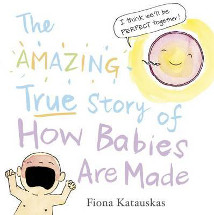The amazing true story of how babies are made by Fiona Katauskas

ABC Books, 2015. ISBN: 9780733333880
(Ages 5+) Highly recommended. There are tried and tested, classic
books explaining how babies are made, but this one makes itself
relevant with its up-to-date information, inclusive of IVF and sperm
donation and other modern baby-making topics. Perfect for use with
children of all ages, the book is ideal for parent use but teachers
will also be able to pick out suitable sections, depending on the
age of the students. It will be especially useful for body
awareness, and relationship and sexual health education. In addition
to providing information, this book will assist children to develop
confidence in their body while encouraging an awareness and
appreciation of difference - both among and between genders and age
groups. Separated into sections, it starts by exploring the
differences between males and females, and then uses this
terminology and information to explain sex and fertilisation; it is
here that information about non-traditional fertilisation is
included. The book then follows the growth and birth of a baby,
including paragraphs about premature babies and caesarean births. It
concludes with the assertion that making babies is one of the most
amazing things that human bodies do and that we are all made this
way! Colourful illustrations, humour and plain English make this an
easy and embarrassment-free title for parents to use. It is
comprehensive and detailed without being dreary and addresses those
things young children are curious about; it explains erections,
puberty and sex in a matter-of-fact and honest way. Diagrams and
pictures are accurate while also being fun, and at times humorous.
Everything is described in a way that even the youngest child will
understand and it has a warm rather than clinical tone. The author
wrote this in response to the lack of any up-to-date material to use
with her own children. It fills an obvious gap and is therefore a
necessary addition to every parent library.
Nicole Smith-Forrest